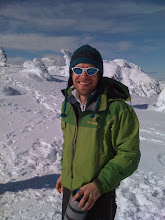It's -44 today in Fairbanks, and I'm home from work for the third time this winter, the second time this week, because of the cold. Our cutoff is -40, although it's an inexact policy. A few weeks ago, we left Fairbanks in the high -30s to work in Delta Junction, where the first morning it was at least -41 and possibly -56. (The thermometer where we were working had bottomed out.) Cords broke on power tools, motors blew out, a truck froze up. One guy's glasses snapped at the bridge. Humans, I came to think, are one of the few things that continue to function well in extreme cold.
For the last four and a half months, I've been working as a weatherization technician for Interior Weatherization Inc., a non-profit that does the state-sponsored weatherization work in Fairbanks and road-accessible areas of the Interior. Our goal is the low-hanging fruit -- not necessarily the simplest fixes, but the ones that will offer the greatest savings for the investment. We replace a lot of inefficient boilers (subcontractors, actually), seal cracks in ceilings and around windows, and add insulation in attics and crawlspaces. We install bathroom fans to control humidity and ensure a healthy exchange of air.
Sometimes it's hard to understand how our work will help. And often, swimming through a sea of cellulose to seal holes in an attic, I curse the builder for not doing it right the first time. But mostly it's rewarding work with clear benefits. In a trailer, you can feel the difference on your skin between a slatted, single-pane window and the triple-pane windows we install. On a frigid day, it just feels right to blow 20 inches of fiberglass into an attic insulated with a thin layer of sawdust and foam packing peanuts. "I've never got a gift like that in my life," said one man after we insulated his attic, rebuilt the skirting around his foundation, and changed some light bulbs.
It's an incredibly generous project of the state, designed to save Alaskans money by making cost-effective improvements they couldn't otherwise afford. I like to think it helps the environment, too, by reducing energy consumption.
For me, it's a big shift from reporting on state politics. Some tasks require real focus, learned skills, and even creativity. But often it's pretty mindless. Which is not always to say simple -- there's a physical skill involved in stapling cardboard baffles to rafters while lying on ceiling joists in a tight eave. I guess that's one of the things I like about it.
I like the guys I work with, and the jobs I can do completely and well. I like blowing an attic for an elderly woman on her birthday. And I like, when a child asks what I'm doing, answering earnestly, "I'm making your house warmer."
Thursday, December 20, 2012
a table
Finally, I have a table!
I live in a small cabin, where space is tight enough that furniture has to multitask. My timber-framing sawhorses serve as seats, stepladders, and makeshift tables. Anything permanent is pushed to the walls, leaving an open space of about eight by eight feet. I've valued that space immensely. I can swing, or stretch, or lay down a tarp and butcher a moose.
My equivalent of the kitchen counter -- the place I spend nearly all my time, and where a guest would choose to sit -- is the wood stove (not at, but next to). It's an OK set up, but I guess there comes a time when a guy wants a table. I designed at least six in Google SketchUp, some bulky and stout, others with Scandinavian curves, most completely deconstructable. The one I finally made is Shaker-inspired, simple and light, and built with leftover rough-cut 2x6s and finished 1x6s. The frame does not come apart. Now, with the third coat of polyurethane drying, I'm almost ready to like it. My eye still fixes on the corner of the top that's not quite flat, but I haven't wanted to burn or otherwise destroy it like some things I've made that I've later come to like. I mostly eyeballed the shape, with some thought given to usage. When the paint is dry, I'll get to see if it's too wide for cribbage or too narrow for dinner with friends. I think it will be perfect for reading the paper with breakfast.
For crafty readers, an explanation: building a table seems to be a lot about keeping the legs vertical (and hence square). Two or four legs, you either need to brace them near the bottom or make the attachment to the top as sturdy as possible, usually with skirting, as I think it's called. I did the latter, and did it the old-fashioned way, with morticed legs and tenons on the ends of the skirting. (Fred Meyer and Pier One tables use diagonal braces screwed into the skirting and legs.) I glued the joints and tapped in pegs made from an oak dowel. There's no hardware in the frame.
I read somewhere that the top should be attached in the middle (assuming the laminated planks run lengthwise) to allow movement with drying. I tried to build tension into the tabletop by giving it a slight convex arc, hoping to make the edges tight as I pulled the center down -- and because a slightly rounded tabletop seemed better than a slightly sunken one. The idea might have been sound, but my execution was a little sloppy (nothing is quite planar in my cabin, let alone regularly convex) and I needed a few more screws to hold the top tight.
Subscribe to:
Comments (Atom)




